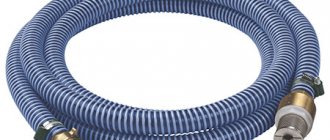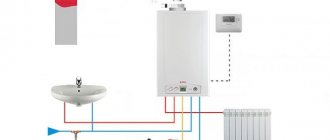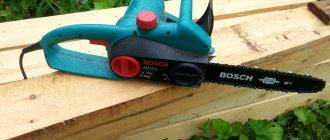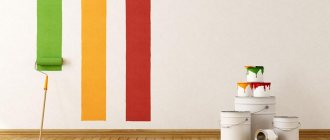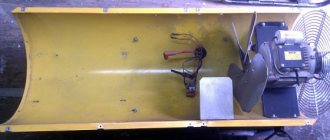A watering hose is an important device, without which it is very difficult to grow plants in your garden. Vegetable beds, berry beds, flower beds, young trees and shrubs will not be able to fully grow and develop without regular watering. The presence of a hose greatly simplifies the life of a summer resident. However, when using a hose, minor troubles and unforeseen difficulties often arise. about how to make using a hose as convenient as possible and choose a garden hose with a minimum number of disadvantages in this article.
How to choose a garden hose that won't cause problems.
To begin with, let's look at the main problems of summer residents that accompany the use of a hose in the garden.
Problems that may arise with a garden hose and their solutions
Perhaps this nuisance is the number one problem that almost every summer resident has encountered.
Often, when choosing a hose, we try to purchase a product of maximum length so that the hose is enough to water the furthest plantings on the site. And often this is what subsequently leads to the hose twisting and forming creases.
Agree, it is very unpleasant to run around the garden and look for exactly where a long hose has bent, or to immediately run to the water tap and put the hose on again, because the kinks often simply tear it off.
It is even more difficult for those who water with an electric pump. For such summer residents, this problem is not just a source of irritation, but also a serious threat of damage to the device. As you know, if the pump cannot fully pump water, it will overheat and “burn out” very quickly. In such situations, it is necessary to either immediately straighten the hose or turn off the device from the network.
As for twists and kinks caused by an excessively long hose, this can be prevented by organizing plastic pipe wiring on the site. This design will allow you to connect small hoses in different parts of the site. Even with the cheapest hoses, with a short length, kinks occur much less frequently, and if they do occur, they can be quickly detected and easier to eliminate.
In addition, this wiring makes it easy to connect an automatic watering system in the desired corner of the garden. For such an external country water supply in the middle zone, HDPE pipes (low-pressure polyethylene pipes) or polypropylene pipes are better suited. But plastic pipes made of PVC (polyvinyl chloride) are more suitable for southern regions, as they may show instability to low winter temperatures.
Of course, the material from which the hose is made and the thickness of its walls play a significant role in the appearance of kinks and twists. Reinforced multilayer PVC hoses practically do not have this problem - the more layers, the less likely it is for creases to occur.
But with more budget (cheap) single-layer options without reinforcement, this problem occurs, as they say, all the time. Moreover, sometimes there are creases even on new products, as they appear during storage in the store.
By the way, the reinforcement can be very different; a fine mesh (4x4 millimeters) will poorly protect the hose from creases. The necessary rigidity for watering hoses is given by braiding with wide cells, and it is very desirable that the design be multi-layered.
Hoses made of rubber, thermoplastic elastomer, as well as the aforementioned multilayer reinforced premium polyvinyl chloride hoses are considered the most resistant to kinks. But the prices for such models, as a rule, are not low. Nevertheless, as experienced summer residents say, nerves are more valuable, and the saying “the miser pays twice” continues to work invariably in the matter of choosing a garden hose.
When using budget-class hoses (in conditions of watering from a water tap), you can use a little trick - install a connector with an aquastop at the outlet end of the hose. In this case, the hose will always be under pressure, which reduces the likelihood of flattened areas and kinks, since the hose is most vulnerable to deformation when there is no water in it.
Excessive length of the hose is the main reason for its kinks and creases.
What to pay attention to when purchasing
Let us once again highlight the main points that will allow you to purchase a high-quality product with a long service life:
- Choose light-proof hoses, this will protect against the unwanted appearance of microorganisms and green walls;
- It is not recommended to purchase cheap Chinese-made hoses, which have a characteristic unpleasant smell of mothballs. It will be unpleasant to work with such a product, and the smell may remain persistent for a long time. It is also worth thinking about the quality of the materials used that have such a smell. It is possible that they can harm young plants;
- Pay attention to the appearance of the product. The color along the entire length should be uniform. The surface should be smooth, but not slip out of your hands. In addition to the fact that the hose must lie securely in the hand, it must also slide freely over the soil;
- When purchasing spiral hoses, consider the perimeter of the site. It may not be effective over large areas. Yes, and manually watering beds of this scale will be very tedious and time-consuming;
- The minimum length of the garden hose should be equal to the maximum distance from the water supply point to the farthest bed;
- If you still cannot decide on the diameter of the internal hole, contact the seller for help;
- Buy products with a wide operating temperature range.
The article was written for the site.
Tags: Landscaping
Persistent kinks in individual parts of the hose
Kinks in the hose usually occur when moving it around the garden while watering, and such minor problems can easily be eliminated by straightening the hose by hand. But it also happens that creases turn into permanent deformation, and then the only option is to cut out the damaged area and connect the remaining parts together.
To repair a damaged hose, you will need two fittings “male” and “female” (it is important to select fittings that fit the cross-section of the hose, most often 1/2 or 3/4 inches); for reliability, the fittings are fixed in the hose with a metal clamp. After this, the “mother” and “father” fittings are connected to each other.
In a similar way, you can use two connectors for garden hoses, connected by a special double for connectors. There are also double hose couplings on sale, which will not only allow you to quickly connect (and, if necessary, easily disconnect) two pieces of hose together. Special models will also help you combine two hoses of different diameters.
It’s even easier to use a small metal tube secured with clamps, if you have a suitable tube diameter. Thanks to such a simple repair, the hose will serve for a long time.
Recommendations for care and use
To ensure trouble-free operation of the hose, it is advisable to take into account your needs when choosing it. If your personal plot is delimited into zones - a garden, a raspberry field, an area under strawberries or tomatoes, a flower bed, shrubs, then for irrigating such a variety it is better to stock up on several options.
If you need to wash your car, then with the availability of various hose options, you won’t have to unwind the 30-meter giant. You can use a convenient stretchable product, the capabilities of which are quite sufficient for washing a car.
Also, regardless of the temperature indicated on the package, the watering hose must be stored correctly. To do this, it is recommended to twist it when irrigation work is completed and the summer water supply is being preserved. First check for blockages inside and rinse with clean water.
It is also undesirable to leave weeping systems and drip irrigation pipes in/on the ground all winter - such hoses, like regular ones, are better washed, twisted and stored in the garage.
An inexpensive reinforced watering hose, despite the stated characteristics, does not tolerate frost and sudden temperature changes. Already in the spring you can see how from flexible and elastic it became oak and brittle
Too weak/strong pressure
If this problem is caused by pressure in the central water supply, then it is not always possible to use radical methods. However, this problem can be slightly corrected by choosing a hose of the correct diameter.
The most common garden hose has a diameter of 1/2 inches, and this is what most of the various attachments (guns, connectors, sprayers, etc.) are designed for. These hoses are lightweight and portable.
Along with this, you can often find a larger diameter hose on sale - 3/4 inches. With the same initial data, the pressure in a thinner hose (1/2 in diameter) will be stronger than in one with a wider hole. However, this is true for a total hose length of no more than 15 meters, since as the length increases, the resistance also increases, which affects the speed of the water jet.
It is better to choose hoses longer than 15 meters with a diameter of 3/4 inches. If watering will be carried out from a pump pumping water from a well, it is recommended to use a hose with a diameter of 3/4 inches, since it is more difficult for the pump to pump water through a narrower tube, which can negatively affect the operation of the device.
The water pressure level of a garden hose is also influenced by its diameter.
Working pressure or burst pressure
Each manufacturer indicates its own characteristics. Some are working, and some are the maximum possible critical pressure. For a simple single-layer watering hose, the maximum pressure is 2 bar, for a multi-layer reinforced one 6-8 bar. The burst pressure for good hoses can reach 30 bar.
It is worth noting that even the cheapest hose will withstand the pressure of water from water pipes. It is necessary to pay attention to water pressure, for example, when using your own well with a deep-well pump.
Holes in water spray accessories become clogged
Typically, this problem occurs when tiny algae grows on the inside walls of the hose. Since algae require light to reproduce, this phenomenon is very common with hoses made of transparent and translucent materials, such as silicone or cheap single-layer PVC hoses.
Therefore, when purchasing, it is initially better to give preference to products with opaque walls. If such a problem already exists, then you can fill the hose with a special solution for combating algae in pools, and leave it with the solution for some time, closing both ends with connectors with aquastop.
When the malfunction of the sprayers is caused by the presence of a large amount of mechanical suspension in the water, which often occurs in summer country water supply systems, then the problem is solved by installing a special filter for the tap.
More expensive models even have a built-in self-washing mechanism, which makes cleaning the filter much easier. By type, mesh and disk filters are most often found; for your dacha, you can choose either one or the other class, since they cope with the task assigned to them approximately equally.
In the store: green, black, yellow
How to choose a hose in a store: by price, color or length? In large stores, popular models are sorted, each buyer has his own argument. All racks are laid out with neat bundles of multi-colored hoses.
Among them, lightweight, seemingly weightless models stand out. There are strong, heavy ones. You can immediately determine the durability of a product by looking at which ones will last for several years and which ones will be good for a couple of seasons. To care for plants, you need a pump that can withstand the pressure.
All technical parameters are indicated on the label for the hose. Managers often duplicate information on the price tag; the buyer immediately sees the main parameters. Not all hoses come in packaging; sellers unwind the required quantity from special equipment.
What should be on the label:
- diameter, measured in inches;
- working pressure, the higher the pressure the watering hose can withstand, the more powerful the injection technique is used;
- Wall thickness;
- material of manufacture;
- presence of reinforcement;
- operating temperature conditions, not everyone can work in sub-zero temperatures;
- lifetime.
Let's look at some parameters in detail and find out whether the internal or external diameter size is indicated on the label and what reinforcement is.
The hose breaks the plants
To eliminate this problem, there are several options that vary in cost and complexity of implementation. The simplest “folk” method is to drive several reinforcing rods around the perimeter of the flower garden or beds, which will reliably hold the hose if it accidentally rushes towards valuable plantings.
Sometimes in gardening stores you can find special guides for the hose, which not only perform their intended function, but also often have a decorative shape and serve as an additional decoration for the site.
The use of specially configured hoses helps to completely forget about this problem. For example, a spiral hose shaped like a children's toy “rainbow”, which, if necessary, easily stretches and independently twists back into a spiral.
Thanks to these properties, the hose does not drag along the ground uncontrollably and does not break plants, and, importantly, does not stain the gardener. However, convenience comes at a price, and such models are expensive compared to traditional hoses.
Another unusual modification is self-expanding nylon hose, which is also sometimes called “miracle hose.” This product significantly increases in size under water pressure, after which it again becomes short and weightless.
When choosing this option, it is worth considering that if the pressure in the system is low, such an option will not be able to work properly, and if it is too high, according to reviews from summer residents, it literally begins to “jump in your hands.”
In addition, gardeners note the unreliability of such models, since the self-extending hose very often breaks and cannot be repaired, and its cost is also very high. For the convenience of using a classic hose, there are special reels in which most of the hose is wound up and does not stretch across the entire section.
Such a compact hose is also less dangerous in terms of breaking plants and, in addition, does not spoil the design of the site by its constant presence in prominent places. There are mechanical and automatic hose reels, and some are designed as carts with wheels for ease of movement.
Also, in the issue of plant breakage when moving the hose, the above-described wiring device made of plastic pipes can be useful, to which, if necessary, short-length hoses are easily connected in different parts of the garden, which are much easier to control, preventing them from getting into flower beds and beds.
Special hose reels help solve the problem of plants breaking during watering.
Comparison table of characteristics
To compare the models discussed above, we present their main parameters in the form of a table.
| Model | Length, m | Diameter, mm | Material | Max. pressure, bar |
| GRINDA EXPERT ½” 50 m | 50 | 13 | PVC | 35 |
| XHOSE Magic Hose 15 m (with spray) | 15 | 20 | special plastic, latex pipe and woven polyester fabric | 16 |
| GARDENA Basic ½” 20 m | 20 | 13 | PVC | 20 |
| HYDRO UNIT watering rubber cord | 25/50 | 12/16/18/20/25 | rubber | 6,3 |
| CALIBER Aqua Line ¾” 25 m | 25 | 19 | PVC | 15 |
| RACO Classic ¾” 25 m | 25 | 19 | PVC | 20 |
| ROSTOK CLASSIC ½” 25 m | 25 | 13 | PVC | 15 |
Difficulty controlling the water flow
Nowadays, there is no longer any need to “freeze your fingers” by pinching the end of the hose to obtain the desired stream, because there are a huge number of so-called watering guns on sale.
Usually this device has several options for spraying water - from a shallow, almost fog-like one, to a strong pressure in one or several jets, allowing you to “finish off” landings at a distance of several meters.
These guns also have a water shut-off mode, which allows you to stop watering without running to the faucet. Most models, in addition, have a “trigger” lock, so that when watering your hand does not strain or get tired at all.
When choosing a pistol, it is important to pay attention to its ergonomics and quality of plastic. There are also elongated spray nozzles on the boom, which help prevent another nuisance - wet feet when watering.
This seemingly tiny problem also causes inconvenience and trouble. Why endure them when the source of irritation can be easily eliminated? Among other things, the model on the bar is very useful for car enthusiasts when washing their cars.
TEP hoses (thermoplastic elastomer)
The most common type of hose in Europe, which combines the positive aspects of rubber and PVC hoses. In recent years, it has also been gaining popularity here. We decided to place this hose in first place due to the presence of numerous positive qualities and a minimum number of disadvantages.
TEP hose (made of thermoplastic elastomer).
Advantages of TEP hoses:
- very durable and will last 15 years or longer;
- does not break or curl, easily restores its shape;
- environmentally friendly (made from environmentally friendly rubber, melted using a special technology);
- possibility of pumping drinking water;
- the hose remains flexible even at temperatures of minus 30 degrees and can be used in the off-season, and, if necessary, in winter;
- you don’t have to bring it indoors for the winter;
- resistant to high pressure (8 atmospheres).
Negative aspects of TEP hose:
- high price;
- not always on sale.
No. 2 – GRINDA
Price: 1,862 rubles
The hose from the manufacturer GRINDA is reinforced with nylon threads and is capable of operating at temperatures from -20 to 50 degrees. Its length is 50 meters and its diameter is 19 mm. It can withstand water pressure up to 15 bar.
This model has good wear resistance and can last for many years. For reinforcement, very strong threads are used, which are applied at an optimal angle to the horizontal axis. High-quality polyvinyl chloride does not deteriorate under the influence of external factors and does not harden in the cold.
Despite the fact that the hose is really well reinforced, it still sometimes bends in places, especially if you stretch it to its full length.
Hose GRINDA
Multilayer PVC hoses
Multilayer PVC hoses are the most popular among summer residents; they have good characteristics and reliably serve when watering the garden. A polyvinyl chloride multilayer garden hose can have from two to six layers. The greater the number of layers, the longer the service life and its resistance to water pressure. Such options, as a rule, also have reinforcement between the layers to prevent creases.
Multilayer PVC hose.
Advantages of multilayer PVC hoses:
- has an optimal price-quality ratio;
- light weight (for models with a diameter of 1/2 inches);
- increased resistance to creases and twisting, the ability to restore shape after compression;
- such hoses are made from environmentally neutral materials;
- resistance to chemical environments (fertilizers, detergents, etc.);
- UV resistant;
- possibility of use under high pressure.
Disadvantages of PVC hoses:
- average service life, compared to more durable rubber and TPE hoses;
- creases and twists still occasionally occur even with multi-layer models;
- at low temperatures the hose hardens greatly (do not use at temperatures below zero degrees).
Video description
In this video you will see what types of garden PVC watering hoses there are and what their advantages are:
The instructions indicate for which crops the emitter pitch is suitable.
Before determining which watering hose to choose for drip irrigation, focus on the following parameters:
- Tape diameter . The standard for personal plots is 16 mm. To irrigate large areas, a 22 mm hydraulic hose is used.
- Wall thickness (unit mil), the higher the number, the stronger the hose. There are three main types: single-season (5-6 mil). For repeated, reusable use, tubes up to 8 mil thick are suitable. In conditions of increased risk from mechanical damage (stones, animals), tubes with wall thicknesses of up to 15 mil are used.
- Amount of water consumed (liter/hour). For a personal plot, 1 to 1.6 liters/hour is sufficient.
- The required pressure varies from 0.2 to 2 atm.
- Resistance of the irrigation hose to UV, salts, microelements.
Hose with a diameter of 16.1 mm Source static-eu.insales.ru
Hoses are distinguished by the type of emitter:
- Slotted . Water flows slowly through spiral gutters, spreading evenly over the soil and moistening it over the entire surface.
- With built-in emitters . Used for root moisture.
The best hoses for watering in the country with economical water consumption are thick-walled tape tubes with emitter droppers. They serve for a long time. Select a hydraulic hose that matches the soil type and agricultural crop.
Rubber hoses
Rubber hoses also have many advantages, and many gardeners prefer them. However, rubber hoses also come with a number of significant disadvantages.
Reinforced rubber hose.
Advantages of rubber hoses:
- Reinforced rubber hoses have the greatest resistance to creases;
- can be used in cool weather;
- UV resistant;
- wear-resistant and durable (more than 10 years);
- There are inexpensive options.
Disadvantages of rubber hoses:
- very heavy weight compared to similar products made from other materials;
- difficult to find on sale;
- high-quality rubber hoses from reliable brands have a high cost;
- The material may be toxic and these hoses are not recommended for drinking water.
Video description
From this video you will learn about Karcher Primoflex watering hoses, what are their differences, how long do they last, and most importantly, is it worth buying them:
Advantages of Karcher hoses:
- high technical parameters: pressure (up to 50 Bar);
- reliability is ensured by a multilayer structure (5 layers), double reinforcement (metal braid, thread);
- the internal protective layer reduces the resistance inside the watering hoses and protects against chemicals;
- the sleeve does not curl;
- The minimum warranty period is 10 years.
German quality is confirmed by a fairly high price.
Kärcher products Source i.simpalsmedia.com
Rehau watering system
A German company has patented a unique hose reinforcement technology (counter threads intertwined at an angle). It allows you to make the sleeve so strong that it can withstand the load of the car. Irrigation hoses do not form kinks.
The products have all the advantages of Karher sleeves. The company has a more thoughtful marketing policy. They produce irrigation systems of three classes: premium, comfort, and universal. Each category is designed for certain loads and service life.
The product warranty is 20 years.
Rehau elastic hose Source fwater.ru
Watering system Gardena
A characteristic feature of elastic pipes for irrigation from a German company: increased wear resistance, reliable connection of elements, thanks to special manufacturing technology. It consists of combining different types of materials (polyvinyl chloride, reinforcement, textile braid). A characteristic feature of the Gardena sleeve is 4 longitudinal stripes along the entire length of the sleeve. This is not just a brand name, but special voltage lines. They allow the gear joints of the fittings to firmly connect the hydraulic hoses.
Garden hoses for irrigation, which ones are best to choose. The company presents several product lines. Contact the store manager, he will select the product in accordance with the required technical characteristics.
The product warranty is 20 years.
Gardena company product Source instrumtorg.ru
Silicone hoses
As a rule, silicone hoses are transparent and resemble medical droppers in appearance.
Silicone hose for watering.
Advantages of silicone hoses:
- very light, almost weightless;
- modifications of small diameter have good resistance to creases;
- most models can be used to supply drinking water;
- the material is environmentally friendly;
- highly resistant to aggressive environments (salts, alkalis, etc.).
Disadvantages of silicone hoses:
- usually have transparent walls, which promotes the growth of algae on the inner walls;
- models with a wide cross-section constantly form creases;
- cannot be used under pressure, problems can arise even at medium pressure (3 atmospheres);
- react negatively to changes in water pressure, therefore they are not recommended when watering from a pump.
Reinforcement
By performing this, the hose manufacturer protects its products from the formation of kinks that impede the flow of water during operation. Reinforcement is carried out using fibers of synthetic origin, they are placed between layers of polymer. This provides the product with high strength and allows it to maintain its shape. It is better to choose hoses with diagonal reinforcement or with a spiral cord structure. Fine mesh reinforcing mesh does not give the desired effect. Models with such reinforcement are cheaper, but it is better to avoid buying them.
Single layer PVC hoses
The most budget option, this is where the advantages of these models end. Watering with such hoses causes a lot of problems for the gardener due to the constant appearance of creases and twists that impede the water supply.
Single layer PVC hose.
Advantages of single-layer PVC hoses:
- increased flexibility;
- a light weight;
- low price;
- easy to find on sale.
Disadvantages of single-layer PVC hoses:
- constant formation of creases and twists;
- short service life;
- average UV resistance;
- not suitable for working under high pressure.
Let's sum it up
- The most common and practical are rubber and polyvinyl chloride or silicone reinforced. The former can be made from recycled materials and be toxic - they are suitable for irrigation. Only food grade versions are suitable for drinking water supply. The second and third ones are environmentally friendly.
- Corrugated plastic and nylon devices are short-lived, but cheap, so it is advisable to keep them in reserve and use them periodically. If you intend to use it, you need to take into account that they are designed for pressures up to 5 bar.
- To ensure greater water supply per unit of time, diameters of 3/4', 5/8', 1' are selected. If the pressure is up to 2 bar, the optimal size is 1/2ʺ.
- For ease of use, a trolley with a reel is additionally purchased. As an option, you can simply buy a stretchable spiral version or a modification like Xhose, as a result of which comfortable watering of the flowerbed will be ensured.
- If irrigation is necessary, the best solutions are oozing hoses with micro-holes along the entire length and special flexible drip irrigation pipes with 3 channels. They can be placed at the roots of plants both on the surface of the earth and in its thickness.
- To simulate natural watering, sprinklers with nozzles are purchased - such products operate in several effective modes, including automatic.
